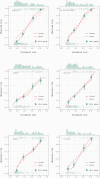Development and Validation of Predictive Model for a Diagnosis of First Episode Psychosis Using the Multinational EU-GEI Case-control Study and Modern Statistical Learning Methods
- PMID: 39145333
- PMCID: PMC11207766
- DOI: 10.1093/schizbullopen/sgad008
Development and Validation of Predictive Model for a Diagnosis of First Episode Psychosis Using the Multinational EU-GEI Case-control Study and Modern Statistical Learning Methods
Abstract
Background and hypothesis: It is argued that availability of diagnostic models will facilitate a more rapid identification of individuals who are at a higher risk of first episode psychosis (FEP). Therefore, we developed, evaluated, and validated a diagnostic risk estimation model to classify individual with FEP and controls across six countries.
Study design: We used data from a large multi-center study encompassing 2627 phenotypically well-defined participants (aged 18-64 years) recruited from six countries spanning 17 research sites, as part of the European Network of National Schizophrenia Networks Studying Gene-Environment Interactions study. To build the diagnostic model and identify which of important factors for estimating an individual risk of FEP, we applied a binary logistic model with regularization by the least absolute shrinkage and selection operator. The model was validated employing the internal-external cross-validation approach. The model performance was assessed with the area under the receiver operating characteristic curve (AUROC), calibration, sensitivity, and specificity.
Study results: Having included preselected 22 predictor variables, the model was able to discriminate adults with FEP and controls with high accuracy across all six countries (rangesAUROC = 0.84-0.86). Specificity (range = 73.9-78.0%) and sensitivity (range = 75.6-79.3%) were equally good, cumulatively indicating an excellent model accuracy; though, calibration slope for the diagnostic model showed a presence of some overfitting when applied specifically to participants from France, the UK, and The Netherlands.
Conclusions: The new FEP model achieved a good discrimination and good calibration across six countries with different ethnic contributions supporting its robustness and good generalizability.
Keywords: cannabis use; diagnostic prediction modeling/risk prediction; psychosis/diagnostic factors.
© The Author(s) 2023. Published by Oxford University Press on behalf of the University of Maryland's school of medicine, Maryland Psychiatric Research Center.
Conflict of interest statement
R.M.M. has received honoraria from Janssen, Sunovian, Lundbeck and Otsuka. M.B. has been a consultant for, received grant/research support and honoraria from, and been on the speakers/advisory board of ABBiotics, Adamed, Angelini, Casen Recordati, Janssen-Cilag, Menarini, Rovi and Takeda. Other authors declare that they have no conflict of interest. All other authors declare no conflict of interest.
Figures

References
-
- Tandon R, Nasrallah HA, Keshavan MS.. Schizophrenia, “just the facts” 4. Clinical features and conceptualization. Schizophr Res. 2009;110(1–3):1–23. - PubMed
-
- Lally J, Ajnakina O, Stubbs B, et al. . Remission and recovery from first-episode psychosis in adults: systematic review and meta-analysis of long-term outcome studies. Br J Psychiatry. 2017;211(6):350–358. - PubMed
-
- Ajnakina O, Stubbs B, Francis E, et al. . Hospitalisation and length of hospital stay following first-episode psychosis: systematic review and meta-analysis of longitudinal studies. Psychol Med. 2020;50(6):991–1001. - PubMed
-
- Ajnakina O, Stubbs B, Francis E, et al. . Employment and relationship outcomes in first-episode psychosis: a systematic review and meta-analysis of longitudinal studies. Schizophr Res. 2021;231:122–133. - PubMed
LinkOut - more resources
Full Text Sources

